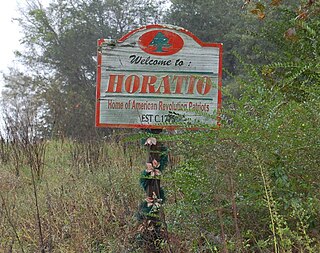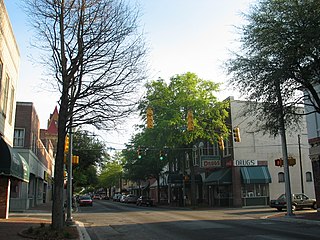
Sumter County is a county located in the U.S. state of South Carolina. As of the 2020 census, the population was 105,556. Its county seat is Sumter.

Lenoir is a city in and the county seat of Caldwell County, North Carolina, United States. The population was 18,263 at the 2020 census. Lenoir is located in the foothills of the Blue Ridge Mountains. To the northeast are the Brushy Mountains, a spur of the Blue Ridge Mountains. Hibriten Mountain, located just east of the city limits, marks the western end of the Brushy Mountains range.

Kinston is a city in Lenoir County, North Carolina, United States, with a population of 19,900 as of the 2020 census. It has been the county seat of Lenoir County since its formation in 1791. Kinston is located in the coastal plains region of eastern North Carolina.

The Church of the Holy Cross is a historic Anglican church at 335 North Kings Highway in Stateburg, South Carolina. Built in 1850-52 to a design by noted South Carolina architect Edward C. Jones, it is a notable example of rammed earth construction with relatively high style Gothic Revival styling. It was designated a National Historic Landmark for its architecture in 1973.

Temple Sinai, also known as Congregation Sinai, whose official name is the Sumter Society of Israelites, is an historic Reform Jewish congregation and synagogue, located at 11-13 Church Street, on the corner of West Hampton Avenue, in Sumter, South Carolina, in the United States.

St. Mark's Episcopal Church is an historic Episcopal church located in the High Hills of Santee west of Pinewood, South Carolina. On January 20, 1978, it was added to the National Register of Historic Places as St. Mark's Church.

The Stateburg Historic District is a historic district in Stateburg, in the High Hills of Santee area near Sumter, South Carolina in the United States. It includes two National Historic Landmarks, Borough House Plantation and the Church of the Holy Cross, and at least eight contributing properties within its boundaries. On February 24, 1971, it was added to the National Register of Historic Places. The historic district extends north and east of the town of Stateburg as far north as Meeting House Road and as far east as South Carolina Highway 441, covering an area of 5,066 acres (20.50 km2).
Singleton's Graveyard is an historic plantation cemetery located off SC 261 in the High Hills of Santee, 6 miles south of Wedgefield, South Carolina. On May 13, 1976, it was added to the National Register of Historic Places.

Horatio is an unincorporated community in the High Hills of Santee area in western Sumter County, South Carolina, United States.

Magnolia Hall is an historic plantation located in the High Hills of Santee at 2025 Horatio-Hagood Road, Hagood, South Carolina. Its Greek Revival plantation house was built in 1821 by its owner Isaac Barnes. After Dr. Swepson Saunders bought the property in 1853, he added onto it in 1855 and 1860.

The High Hills of Santee, sometimes known as the High Hills of the Santee, is a long, narrow hilly region in the western part of Sumter County, South Carolina. It has been called "one of the state's most famous areas". The High Hills of Santee region lies north of the Santee River and east of the Wateree River, one of the two rivers that join to form the Santee. It extends north almost to the Kershaw county line and northeasterly to include the former summer resort town of Bradford Springs. Since 1902 the town has been included in Lee County.

Pinewood Depot is an historic railway station located at the junction of East Avenue and Clarke Street in the town of Pinewood, at the southern entrance of the High Hills of Santee, South Carolina. It is the only railroad station left in Sumter County, but is not longer used by CSX, the current owner of the railroad right-of-way. On June 10, 1997, it was added to the National Register of Historic Places.

The Sumter County Courthouse, built in 1907, is an historic courthouse located at 141 North Main Street in the city of Sumter in Sumter County, South Carolina. It was designed in the Beaux Arts style by Darlington native William Augustus Edwards who designed eight other South Carolina courthouses as well as academic buildings at 12 institutions in Florida, Georgia and South Carolina. It was built in an I-shape. In the early 1960s it was enlarged and remodeled. On June 16, 2004, it was added to the National Register of Historic Places. It is located in the Sumter Historic District.

The O'Donnell House in Sumter, South Carolina, also known as Haynsworth-Bogin-O'Donnell House or as Shelley-Brunson Funeral Home, was built in 1840. It was listed on the National Register of Historic Places in 1996.

The Heriot-Moise House, also known as Ingleside, is an historic plantation house located on Brewington Road at Oswego Highway U.S Highway 401 north of Sumter in Sumter County, South Carolina. It is "significant for its illustration of evolving architectural forms and influences from ca. 1790 into the twentieth century, as altered from an essentially vernacular hall-and-parlor house to a residence with Early Classical revival and Greek revival influences. Extant features from the original house and the ca. 1800, ca. 1830, ca. 1850, and later alterations show how succeeding owners adapted the house to their changing needs and circumstances. It is also significant as a basically intact nineteenth and early twentieth century farm complex."

Goodwill Parochial School, also known as Goodwill Day School, was a parochial school for African American children located near Mayesville, Sumter County, South Carolina. It was added to the National Register of Historic Places in 1997.
Mayesville Historic District is a national historic district located at Mayesville, Sumter County, South Carolina. It encompasses 62 contributing buildings in the western half of the town of Mayesville. It includes a broad range of late-19th and early-20th century vernacular architectural design, including commercial, residential (majority), and religious buildings. The district includes representative examples of the Neo-Classical, Victorian, Queen Anne, Colonial Revival, Greek Revival, and Bungalow. Notable buildings include the Town Hall, Kineen Hotel, Bland Stables, Granit Building, Davis Store, J. W. Rhodes House, and R. J. Mayes House.

Sumter Historic District is a national historic district located at Sumter, Sumter County, South Carolina. It encompasses 62 contributing buildings in the central business district of Sumter. It includes buildings that primarily date from 1880 to 1912. They are typical of turn-of-the-20th century commercial buildings, using materials such as pressed tin, limestone, and brick. Notable buildings include the Sumter County Courthouse, Sumter Town Hall-Opera House, Lee and Moise Building, Bultman Brothers' Boots and Shoes, Bank of Sumter, and Burns Hardware.

Harmony Hall, also known as the Peebles House, is a historic building located at 109 East King Street in Kinston, North Carolina, United States. The 18th-century house, the oldest building in Kinston, was owned by North Carolina's first elected governor. The house briefly served as the de facto state capitol during the Revolutionary War. The building has been expanded and renovated throughout its history, transitioning from the Georgian and Federal styles to Greek Revival. One of the prominent features of the house is the two-story porch on the facade. Harmony Hall was added to the National Register of Historic Places (NRHP) in 1971 and serves as a house museum operated by the Lenoir County Historical Association.
Granby was the first European settlement in the area of present-day Columbia in the U.S. state of South Carolina. Settlement began around 1718 with the establishment of a trading post by the British on the Congaree River. Many small farms were settled by German, Swiss, and Scots-Irish immigrants. Granby was the largest town and county seat of Lexington County until the early 19th century, when the town began to gradually decline as Columbia, the state capital, grew. The once thriving colonial town was mostly unoccupied after the first quarter of the 19th century. Today, the area is part of present-day Cayce.


















